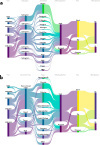Mapping Important Shark and Ray Areas (ISRAs) in the Central and South American Pacific: Existing knowledge and data needs
- PMID: 40333947
- PMCID: PMC12058020
- DOI: 10.1371/journal.pone.0322445
Mapping Important Shark and Ray Areas (ISRAs) in the Central and South American Pacific: Existing knowledge and data needs
Abstract
Identifying critical habitats is key to the conservation and recovery of threatened species. A third of chondrichthyans (sharks, rays, and chimaeras) are threatened with extinction but robust biological and ecological information to delineate critical habitats for many species remains limited. Here, we investigated (1) research outputs and trends across the Central and South American Pacific region to determine whether sufficient information was available to identify critical habitats; (2) whether regional Important Shark and Ray Areas (ISRAs) were spatially representative; (3) what species and which ecological traits were most commonly used in the delineation of critical habitats; and (4) discuss how ISRAs can inform research priorities and area-based management in support of chondrichthyan conservation. Sixty-five ISRAs were identified for 97 of 190 chondrichthyan species occurring in the region (51%). Across key life-history processes, reproductive areas were most identified (n = 50). Of 821 published studies (2,160 entries), 31.48% (28% entries) primarily focused on fisheries and 48.51% included enough information to inform the ISRA process. Most (58.98%) of these studies originated from Mexico (n = 342, 744 entries) and Ecuador (n = 147, 276 entries). France and Honduras had the least regional research outputs relevant to apply the ISRA Criteria. Significant ecological data gaps were identified in oceanic (including areas beyond national jurisdiction), deepwater (>200 m), and along the southern part of the region (i.e., southern Chile). Deepwater species, chimaeras, and 21% of threatened species had knowledge gaps that did not allow the identification of ISRAs. If area-based management decisions in this region were based on ISRAs, and effectively implemented and enforced, diversity hotspots and at least 97 species could receive protection, including 79% of threatened species and 54% of those considered range-restricted. Increased monitoring and research efforts, with a corresponding increase in funding to fill existing gaps is key to support the identification of important habitats across this region.
Copyright: © 2025 García-Rodríguez et al. This is an open access article distributed under the terms of the Creative Commons Attribution License, which permits unrestricted use, distribution, and reproduction in any medium, provided the original author and source are credited.
Conflict of interest statement
The authors have declared that no competing interests exist.
Figures







References
-
- Hyde CA, Notarbartolo di Sciara G, Sorrentino L, Boyd C, Finucci B, Fowler SL, et al.. Putting sharks on the map: A global standard for improving shark area-based conservation. Front Mar Sci. 2022;9:968853. doi: 10.3389/fmars.2022.968853 - DOI
-
- Patlis J Paying tribute to Joseph Heller with the endangered species act: When critical habitat isn’t. Stanford Environ Law J. 2001;20:133–217.
-
- Bird SC, Hodges KE. Critical habitat designation for Canadian listed species: Slow, biased, and incomplete. Environ Sci Policy. 2017;71:1–8. doi: 10.1016/j.envsci.2017.01.007 - DOI
-
- Vance M. The biological foundation of critical habitat for species at risk: a literature review. Canadian Wildlife Service; 2003.
MeSH terms
LinkOut - more resources
Full Text Sources

